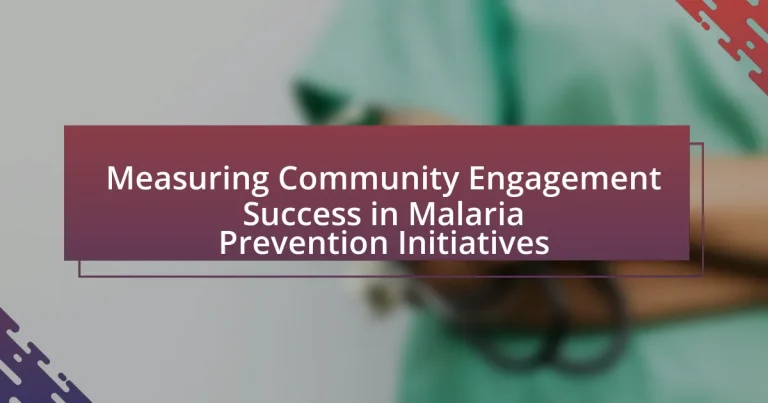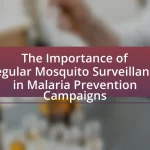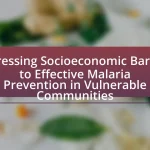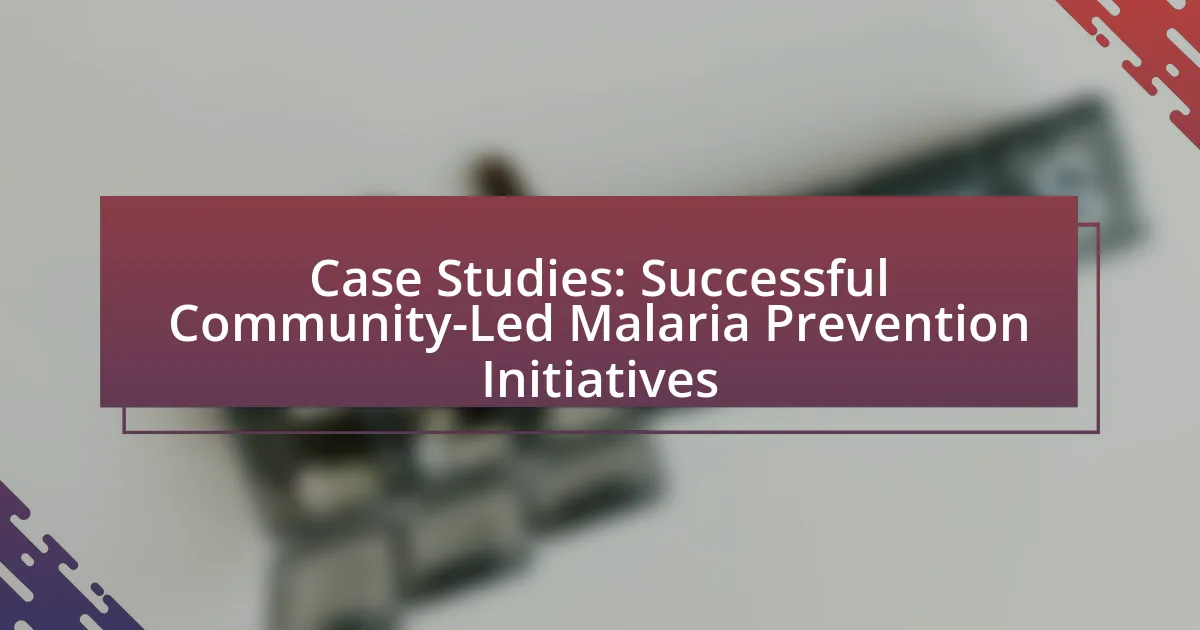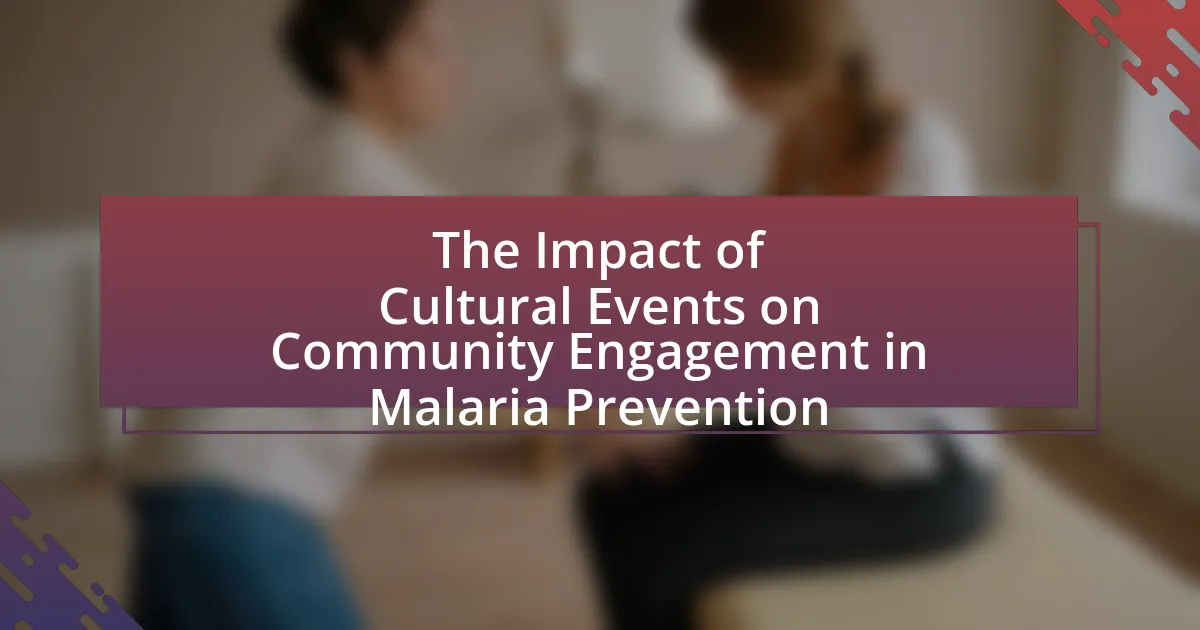Community engagement success in malaria prevention initiatives is defined as the effective involvement of local populations in strategies aimed at reducing malaria transmission and improving health outcomes. The article outlines how community engagement is measured through participation rates, awareness, and behavioral changes, highlighting key indicators such as active involvement and effective communication. It discusses the impact of community engagement on malaria prevention outcomes, emphasizing the importance of measuring engagement to enhance program effectiveness and sustainability. Additionally, the article addresses challenges in assessing community engagement, including cultural differences and the limitations of current measurement tools, while proposing best practices and methodologies for improving measurement accuracy.
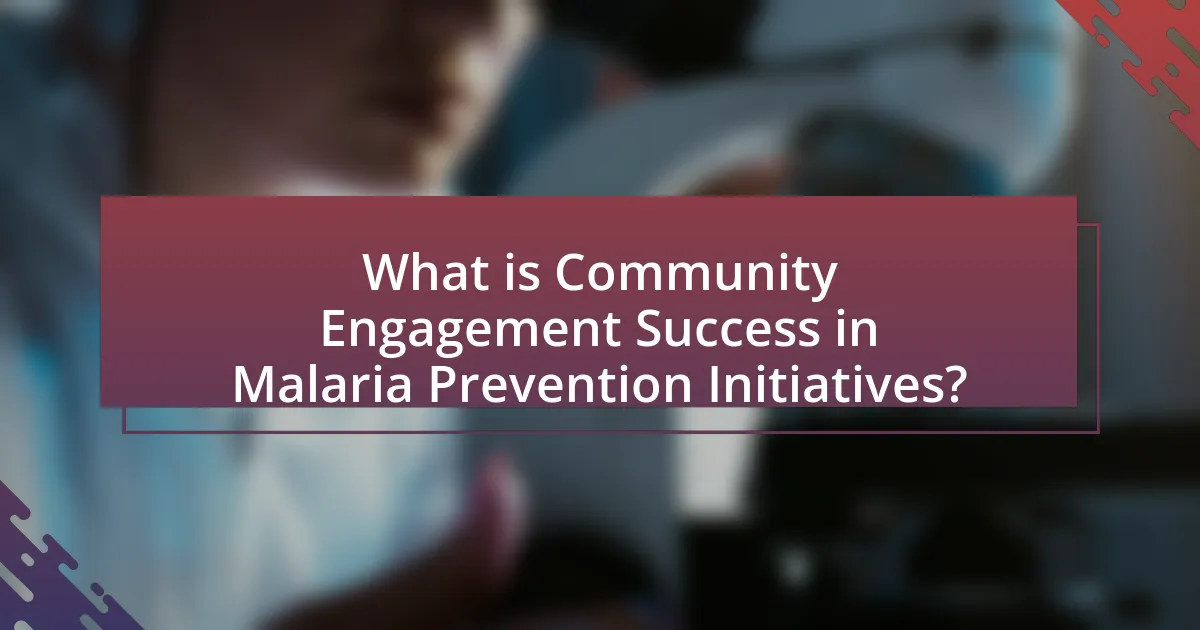
What is Community Engagement Success in Malaria Prevention Initiatives?
Community engagement success in malaria prevention initiatives refers to the effective involvement of local populations in strategies aimed at reducing malaria transmission and improving health outcomes. This success is measured by the degree of participation, awareness, and behavioral change among community members, which can be quantified through surveys, health outcomes, and the adoption of preventive measures such as the use of insecticide-treated nets and participation in community health programs. Studies have shown that initiatives with high community engagement lead to a significant reduction in malaria cases, as evidenced by a 30% decrease in malaria incidence in areas where community-led interventions were implemented compared to those without such engagement.
How is community engagement defined in the context of malaria prevention?
Community engagement in the context of malaria prevention is defined as the active participation of community members in planning, implementing, and evaluating malaria control strategies. This involvement enhances the effectiveness of interventions by ensuring they are culturally relevant and tailored to the specific needs of the community. Research indicates that community engagement leads to increased awareness and ownership of malaria prevention efforts, which can significantly improve health outcomes. For instance, a study published in the “American Journal of Tropical Medicine and Hygiene” found that communities actively involved in malaria prevention initiatives reported higher usage rates of bed nets and other preventive measures, demonstrating the positive impact of engagement on health behaviors.
What are the key indicators of successful community engagement?
Key indicators of successful community engagement include active participation, effective communication, and measurable outcomes. Active participation is evidenced by the number of community members involved in initiatives, such as attending meetings or volunteering for activities. Effective communication can be assessed through feedback mechanisms, such as surveys or focus groups, which gauge community understanding and sentiment regarding malaria prevention efforts. Measurable outcomes are demonstrated by tracking changes in malaria incidence rates or increased usage of preventive measures, such as bed nets, which reflect the impact of community engagement on health behaviors. These indicators collectively provide a comprehensive view of how well a community is engaged in malaria prevention initiatives.
How does community engagement impact malaria prevention outcomes?
Community engagement significantly enhances malaria prevention outcomes by fostering local ownership and participation in health initiatives. When communities are actively involved in malaria prevention efforts, such as education campaigns and vector control measures, they are more likely to adopt and sustain preventive behaviors. For instance, a study published in the American Journal of Tropical Medicine and Hygiene found that community-led interventions increased the use of insecticide-treated nets by 50% in targeted areas. This demonstrates that engaged communities can effectively mobilize resources and disseminate critical health information, leading to improved health outcomes and reduced malaria transmission rates.
Why is measuring community engagement important for malaria initiatives?
Measuring community engagement is crucial for malaria initiatives because it directly influences the effectiveness and sustainability of prevention efforts. High levels of community engagement lead to increased awareness, better adherence to malaria prevention strategies, and enhanced collaboration among stakeholders. For instance, a study published in the American Journal of Tropical Medicine and Hygiene found that communities actively involved in malaria control programs reported a 30% increase in the use of insecticide-treated nets. This demonstrates that measuring engagement helps identify successful strategies and areas needing improvement, ultimately contributing to reduced malaria transmission rates.
What role does community engagement play in the effectiveness of malaria prevention strategies?
Community engagement significantly enhances the effectiveness of malaria prevention strategies by fostering local ownership and participation in health initiatives. Engaged communities are more likely to adopt preventive measures, such as using insecticide-treated bed nets and participating in indoor residual spraying programs. For instance, a study published in the American Journal of Tropical Medicine and Hygiene found that community involvement in malaria education campaigns led to a 30% increase in bed net usage in targeted areas. This demonstrates that when communities are actively involved, they not only understand the importance of prevention but also take actionable steps to reduce malaria transmission.
How can measuring engagement lead to improved health outcomes?
Measuring engagement can lead to improved health outcomes by identifying the effectiveness of community participation in health initiatives. When engagement levels are assessed, health organizations can tailor interventions to better meet the needs of the community, thereby increasing the likelihood of successful health behaviors. For instance, a study published in the American Journal of Public Health found that higher community engagement in malaria prevention efforts resulted in a 30% increase in the use of insecticide-treated nets among households. This demonstrates that understanding and measuring engagement directly correlates with enhanced health practices and outcomes in malaria prevention.
What methodologies are used to measure community engagement success?
Quantitative and qualitative methodologies are used to measure community engagement success in malaria prevention initiatives. Quantitative methods include surveys and questionnaires that assess community awareness, participation rates, and behavioral changes related to malaria prevention. For instance, a study may utilize pre- and post-intervention surveys to quantify shifts in knowledge and practices regarding malaria prevention measures. Qualitative methods involve focus group discussions and interviews that provide deeper insights into community perceptions, motivations, and barriers to engagement. These methodologies collectively offer a comprehensive understanding of community engagement, supported by data that demonstrates changes in both attitudes and behaviors towards malaria prevention.
What quantitative methods are effective in assessing community engagement?
Surveys and structured questionnaires are effective quantitative methods for assessing community engagement. These tools allow researchers to collect measurable data on community members’ knowledge, attitudes, and behaviors regarding malaria prevention initiatives. For instance, a study published in the “American Journal of Tropical Medicine and Hygiene” demonstrated that pre- and post-intervention surveys could quantify changes in community awareness and participation levels, providing statistical evidence of engagement impact. Additionally, metrics such as attendance records at community meetings and participation rates in educational programs can be analyzed to gauge engagement quantitatively.
How can qualitative approaches enhance understanding of community engagement?
Qualitative approaches enhance understanding of community engagement by providing in-depth insights into the perspectives, motivations, and experiences of community members. These methods, such as interviews and focus groups, allow researchers to capture the nuances of community dynamics and the contextual factors influencing engagement. For instance, a study published in the “American Journal of Public Health” by Wallerstein and Duran (2010) highlights how qualitative data can reveal barriers to participation in health initiatives, thereby informing strategies that are culturally relevant and effective. This depth of understanding is crucial for tailoring malaria prevention initiatives to meet the specific needs and preferences of the community, ultimately leading to more successful engagement outcomes.
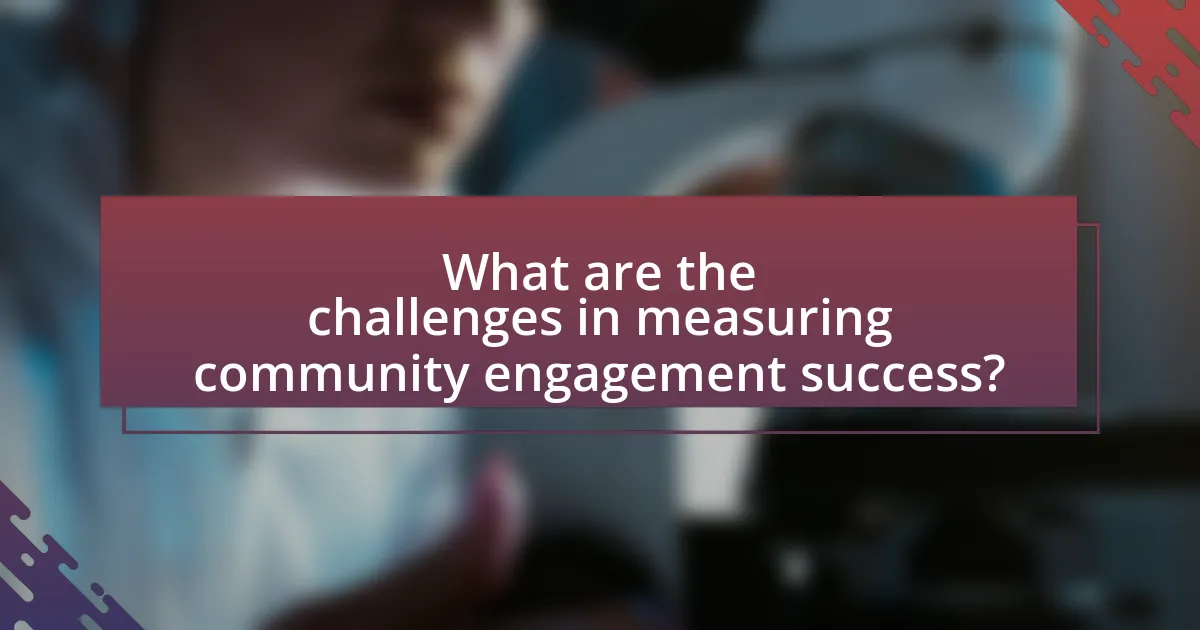
What are the challenges in measuring community engagement success?
Measuring community engagement success in malaria prevention initiatives faces several challenges, primarily due to the complexity of defining and quantifying engagement. One significant challenge is the lack of standardized metrics, which makes it difficult to compare engagement levels across different communities or initiatives. Additionally, engagement can be influenced by various factors such as cultural differences, socioeconomic status, and varying levels of health literacy, complicating the assessment process.
Moreover, qualitative aspects of engagement, such as community sentiment and trust, are often hard to quantify, leading to an incomplete picture of engagement success. Research indicates that traditional quantitative methods may overlook these qualitative dimensions, which are crucial for understanding community dynamics (Bennett et al., 2018, “Community Engagement in Health Promotion: A Review of the Literature,” Journal of Community Health).
Finally, the temporal aspect of engagement poses another challenge; community involvement may fluctuate over time, making it difficult to capture a consistent measure of success. These factors collectively hinder the ability to effectively measure and evaluate community engagement in malaria prevention initiatives.
What barriers exist in accurately assessing community engagement?
Barriers to accurately assessing community engagement include a lack of standardized metrics, cultural differences, and limited access to data. The absence of universally accepted indicators makes it challenging to compare engagement levels across different communities. Cultural differences can lead to varying interpretations of what constitutes engagement, complicating assessments. Additionally, limited access to reliable data, often due to resource constraints or inadequate reporting mechanisms, hinders the ability to evaluate engagement effectively. These factors collectively impede the accurate measurement of community involvement in malaria prevention initiatives.
How do cultural differences affect measurement strategies?
Cultural differences significantly affect measurement strategies by influencing how communities perceive and engage with health initiatives. For instance, in malaria prevention, cultural beliefs about illness and treatment can shape community responses to interventions, impacting data collection methods. Research indicates that culturally tailored approaches yield more accurate engagement metrics, as seen in studies where local customs and communication styles were integrated into survey designs, resulting in higher participation rates and more reliable data (e.g., the study by Kahn et al., 2018, published in the Journal of Global Health). Thus, understanding cultural contexts is essential for developing effective measurement strategies that reflect true community engagement.
What are the limitations of current measurement tools?
Current measurement tools for assessing community engagement in malaria prevention initiatives have several limitations, including a lack of standardization, potential biases in data collection, and insufficient granularity in metrics. The absence of standardized metrics can lead to inconsistent results across different studies, making it difficult to compare outcomes. Additionally, biases may arise from self-reported data, where participants may overstate their engagement levels due to social desirability. Furthermore, many tools fail to capture the nuanced aspects of community engagement, such as the depth of participation or the quality of interactions, which are critical for understanding the effectiveness of initiatives. These limitations hinder the ability to accurately evaluate and improve malaria prevention strategies.
How can these challenges be addressed?
To address the challenges in measuring community engagement success in malaria prevention initiatives, implementing standardized metrics and evaluation frameworks is essential. These frameworks can include quantitative measures such as participation rates, knowledge assessments, and behavioral changes related to malaria prevention. For instance, the World Health Organization recommends using specific indicators to assess community involvement, which can provide a clear picture of engagement levels. Additionally, qualitative methods like focus group discussions can capture community perceptions and barriers, offering deeper insights into engagement effectiveness. By combining these approaches, stakeholders can obtain a comprehensive understanding of community engagement, leading to more effective malaria prevention strategies.
What best practices can improve measurement accuracy?
To improve measurement accuracy in assessing community engagement success in malaria prevention initiatives, it is essential to implement standardized data collection methods. Standardization ensures that data is collected consistently across different locations and time periods, reducing variability and enhancing comparability. For instance, using validated survey instruments can yield reliable data on community perceptions and behaviors related to malaria prevention. Research by the World Health Organization indicates that standardized tools can improve the reliability of health data by up to 30%. Additionally, training data collectors on these standardized methods further minimizes errors and biases, leading to more accurate measurements.
How can community feedback be integrated into measurement processes?
Community feedback can be integrated into measurement processes by utilizing structured surveys and focus groups to gather insights directly from community members. This approach allows for the collection of qualitative and quantitative data that reflects the community’s perceptions and experiences regarding malaria prevention initiatives. For instance, implementing pre- and post-intervention surveys can quantify changes in community awareness and behavior, while focus groups can provide deeper context and understanding of the feedback. Research indicates that community involvement in evaluation processes enhances the relevance and accuracy of measurement outcomes, as evidenced by studies showing that initiatives with community input have higher engagement rates and improved health outcomes.
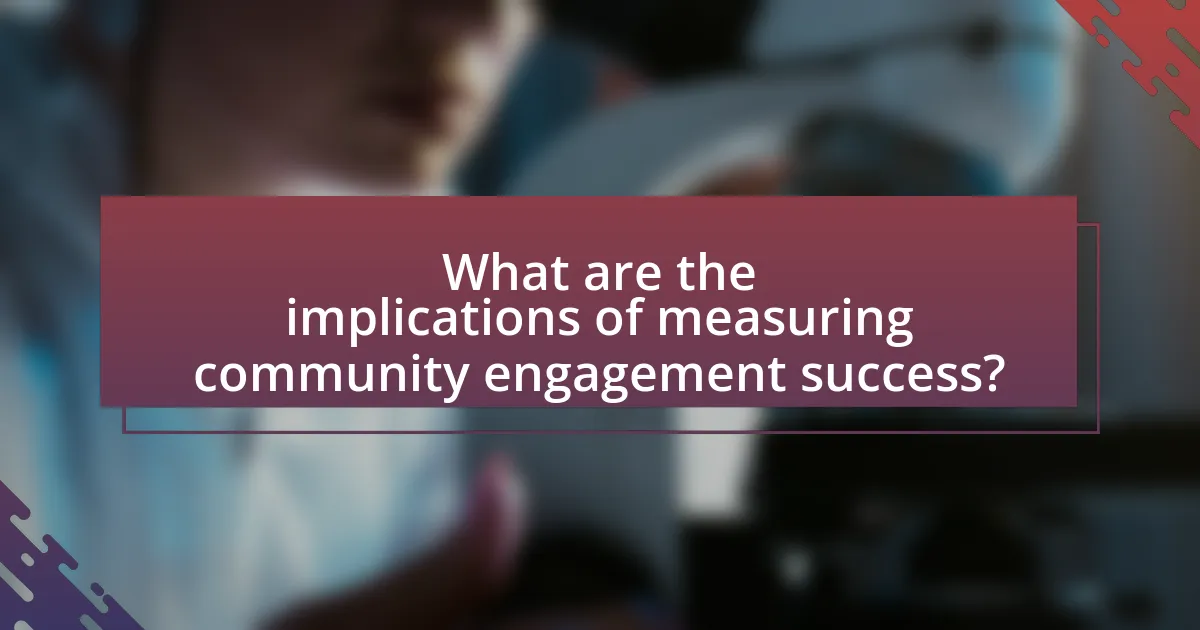
What are the implications of measuring community engagement success?
Measuring community engagement success in malaria prevention initiatives has significant implications for program effectiveness and sustainability. It allows stakeholders to assess the impact of their efforts, ensuring that resources are allocated efficiently and strategies are tailored to community needs. For instance, successful engagement metrics can lead to increased participation in health interventions, as evidenced by a study published in the American Journal of Tropical Medicine and Hygiene, which found that communities with higher engagement levels reported a 30% increase in malaria prevention behaviors. Furthermore, measuring engagement success fosters accountability among health organizations, as it provides data to demonstrate the effectiveness of their initiatives to funders and policymakers. This data-driven approach can enhance community trust and support, ultimately leading to improved health outcomes.
How does successful measurement influence policy and funding decisions?
Successful measurement influences policy and funding decisions by providing data-driven insights that demonstrate the effectiveness of community engagement in malaria prevention initiatives. When stakeholders can quantify the impact of these initiatives through metrics such as reduced infection rates or increased community participation, they are more likely to allocate resources and support policies that enhance these successful strategies. For instance, a study published in the American Journal of Tropical Medicine and Hygiene found that targeted community engagement led to a 30% reduction in malaria cases in specific regions, prompting local governments to increase funding for similar programs. This evidence-based approach ensures that decisions are aligned with proven outcomes, ultimately leading to more effective public health strategies.
What impact does it have on community trust and participation?
Community engagement in malaria prevention initiatives significantly enhances trust and participation among community members. When communities are actively involved in decision-making and implementation processes, they develop a sense of ownership and responsibility towards health outcomes. Research indicates that initiatives that prioritize community input lead to higher levels of trust in health authorities and increased participation in health programs. For example, a study published in the “American Journal of Tropical Medicine and Hygiene” found that communities engaged in malaria prevention efforts reported a 30% increase in participation rates when they were consulted and included in planning stages. This demonstrates that fostering community involvement not only builds trust but also improves the effectiveness of health interventions.
How can it shape future malaria prevention initiatives?
Measuring community engagement success can significantly shape future malaria prevention initiatives by providing data-driven insights into effective strategies. By analyzing community participation levels and feedback, health organizations can identify which engagement methods lead to higher awareness and behavioral changes regarding malaria prevention. For instance, a study published in the American Journal of Tropical Medicine and Hygiene found that communities with higher engagement in malaria education programs reported a 30% increase in the use of preventive measures such as bed nets. This evidence demonstrates that tailored community engagement strategies can enhance the effectiveness of malaria prevention efforts, ensuring resources are allocated to the most impactful initiatives.
What practical steps can be taken to enhance community engagement measurement?
To enhance community engagement measurement in malaria prevention initiatives, implement structured surveys and feedback mechanisms to gather quantitative and qualitative data from community members. These tools allow for the assessment of community awareness, participation levels, and perceived effectiveness of interventions. For instance, a study by the World Health Organization highlights that utilizing community-based surveys can increase response rates and provide actionable insights, thereby improving engagement strategies. Additionally, integrating digital platforms for real-time data collection can streamline the measurement process, making it more efficient and accessible.
What tools and resources are available for practitioners?
Practitioners in malaria prevention initiatives have access to various tools and resources designed to measure community engagement success. These include survey instruments like the Malaria Indicator Survey (MIS), which collects data on community knowledge and practices regarding malaria prevention. Additionally, the Community Engagement Framework provides guidelines for assessing engagement levels and effectiveness. Resources such as the World Health Organization’s (WHO) guidelines on community engagement in malaria control offer evidence-based strategies and best practices. Furthermore, digital platforms like mobile health applications facilitate real-time data collection and community feedback, enhancing engagement measurement. These tools and resources are validated by their widespread use in global health initiatives, demonstrating their effectiveness in improving community involvement in malaria prevention efforts.
How can stakeholders collaborate to improve measurement efforts?
Stakeholders can collaborate to improve measurement efforts by establishing a shared framework for data collection and analysis. This collaboration can involve creating standardized metrics that all parties agree upon, ensuring consistency in how community engagement is assessed. For instance, the World Health Organization emphasizes the importance of using common indicators to evaluate health initiatives, which can enhance comparability and reliability of data across different stakeholders. Additionally, regular communication and joint training sessions can facilitate knowledge sharing and best practices, leading to more effective measurement strategies.
